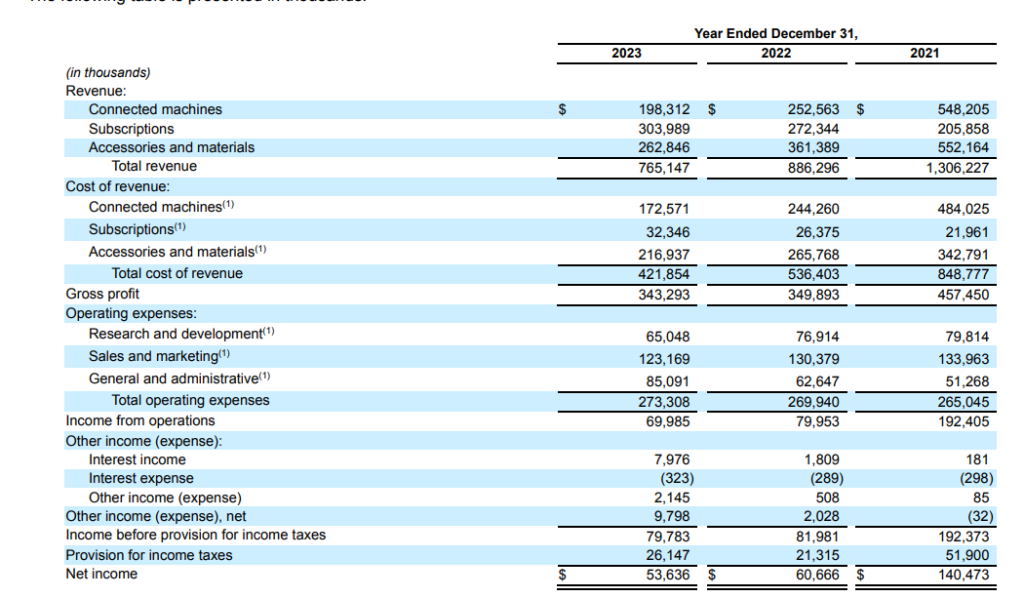Today, more and more people want to be surrounded by personalized items. According to a study by Deloitte, one in four consumers is willing to pay more to receive a personalized product or service. Additionally, over 35% of consumers expressed interest in purchasing customized products or services in furniture, homeware, and DIY goods. Cricut empowers individuals to personalize.
Consumers have access to more tools in the digital world than ever before. They are easier to use, more powerful and available on every device. The power to create and manipulate content – text, audio, or video – can now be done from anyone’s smartphone or laptop. Cricut has built on this trend by offering both digital and physical tools and, more importantly, bridging these two worlds together.
The rapid growth of marketplaces and commerce enablement platforms creates economic opportunities for millions of creative entrepreneurs. Individual entrepreneurs value supplemental income, flexibility, and the opportunity to do what they love for a living.
According to Upwork’s 2019 “Freelancing in America” report, 15 million Americans are freelancers who sell goods, and 75% of arts and design professionals are freelancers. Cricut enables the shift in production of physical goods from factory floors to kitchen tables and provides manufacturing solutions for small-scale businesses. In this story, let’s understand what it does Cricut do and how does Cricut work?
What does Cricut do?
Cricut’s mission is to help people lead creative lives. Cricut’s creativity platform enables its engaged and loyal community of nearly 8.9 million users, as of December 31, 2023, to turn ideas into professional-looking handmade goods.
Using Cricut’s design software and its highly versatile ecosystem of connected machines, accessories, and materials, users can create everything from personalized birthday cards and party décor to custom apparel and home goods to large-scale interior decorations and more.
This ecosystem was designed and built for scalability and seamless integration, allowing Cricut to introduce new products and continuously update the functionality and features of existing physical and digital products. This makes Cricut’s platform broadly extensible and empowers its users to unlock ever-expanding creative potential.
The Cricut platform centers around cloud-based software, meaning users can access and work on their projects anywhere, anytime, across desktop and mobile devices. This software aggregates billions of data points of its users’ contributions, giving Cricut valuable insights into their preferences and behaviors, enabling it to improve products and continuously drive further engagement.
Cricut extends its platform’s inspiring and intuitive nature to its hardware, with connected machines that are beautiful and easy to use. Cricut portfolio of connected machines cut, write, score, and create decorative effects for a wide range of use cases on an array of materials, including paper, vinyl, and leather.
These machines are available at a variety of price points:
- Cricut Joy for personalization, organization, and customization, $179.00 MSRP
- Cricut Explore family for cutting, writing, and scoring, $249.00 – $319.00 MSRP
- Cricut Maker family for cutting, writing, scoring, and adding decorative effects to a broader range of materials, $399.00 – $429.00 MSRP
Cricut often becomes a huge part of its users’ creative lives, serving as the foundation for their journey of creativity. These journeys typically begin with the purchase of a machine and expand across Cricut’s family of products as users harness the power of its platform.
Cricut’s users demonstrate continued engagement with its platform over time, resulting in purchases of subscriptions, accessories, and materials long after purchasing a connected machine. As of December 31, 2022, 51% of its users created on their connected machines in the last 90 days, and 74% created in the last 365 days.
In Cricut’s design apps, users can find inspiration, purchase or upload content like fonts and images, design a project from scratch, or find a vast array of ready-to-make projects on mobile and desktop devices. All users can take advantage of a select number of free images, fonts, and projects from Cricut’s design apps or upload unlimited designs.
In addition, Cricut offers a wider selection of images, fonts, and projects for purchase à la carte, including licensed content from its partners, such as well-known characters, designs, and other trademarks from various brands.
Many of Cricut’s users share a love of the brand, products, and mission, which fosters a loyal community of users who are deeply engaged with Cricut and each other. Every project is an opportunity to start a conversation, and Cricut often sees its users inspire, teach, and create together.
Users are passionate about sharing Cricut tips, tricks, and personal stories, and this engagement carries over into social media and into everyday life. There are more than six million Cricut followers and hundreds of independently run Cricut groups across social media. Users often self-organize, host independent events, and meet up in person across the globe.
Cricut software also puts community ideas and inspiration front and center and encourages interaction with one another through several sharing and social features. As the number of Cricut’s users grows, so does the number of projects made and shared physically or digitally through the reinforcing network effect. This generates even more shared projects and word-of-mouth that, in turn, help to grow Cricut’s community.
How does Cricut work?
Cricut’s Software
Cricut’s cloud-based software integrates its connected machines and design apps, allowing users to create and share seamlessly from anywhere, anytime, across desktops or mobile devices. Cricut’s software aggregates billions of data points of Cricut’s users’ contributions, giving Cricut valuable insights into its users’ preferences and behaviors.
As users create with or upload images, designs, projects, community networks, and more, this information continuously syncs across their devices and within Cricut’s data warehouse. Having direct access to this data allows Cricut to monitor how users engage with product features, giving Cricut the insights to improve and expand if needed efficiently or sunset products when no longer useful.
Connected Machines
Cricut’s connected machine portfolio currently includes Cricut Joy, the Cricut Explore family, and the Cricut Maker family. These machines cut, write, score, and create decorative effects using various tools and materials, including paper, vinyl, leather, and more.
They are designed for uses ranging from quick, everyday projects like labels, decals, and greeting cards to professional-level DIY projects like personalized apparel, signage, and home décor. Cricut’s connected machines also use different combinations of tools, attachments, and accessories for deeper capabilities.
Design Apps and Subscriptions
Users leverage Cricut’s connected machines and design apps to bring their ideas to life. Users can access a select number of free images, fonts, and ready-to-make projects or upload their designs to begin making.
Ready-to-make projects, ranging in complexity from cards to home décor, each come with instructions and recommendations for the ideal materials. Users can save projects to their profile and share their designs with others — directly on Cricut’s platform and through unique web links and social platforms.
Cricut Extensions, Accessories, and Materials
Cricut sells a broad range of extensions, accessories, and materials designed to work seamlessly with its connected machines. The Cricut heat press line, including the Cricut EasyPress family, Cricut Mug Press, Cricut Hat Press, and Cricut Autopress, offers carefully calibrated companions for heat-transfer vinyl projects such as personalized apparel or sublimated goods.
This line of heat presses replaces traditional irons and heat transfer tools with products that deliver consistent, even, and precise control. Cricut’s line of lighting products, which includes Cricut Bright in table and floor lamp options and the popular Cricut BrightPad and BrightPad Go, illuminate surfaces and surroundings for easier crafting and creating.
Cricut materials give users peace of mind with a brand they trust for durability, selection, and compliance. Cricut sells various project materials, including vinyl, iron-on vinyl, deluxe paper, and Infusible Ink (cuttable sublimation).
Machine and hand tools also support multiple forms of creativity, from fine point blades for vinyl and cardstock, rotary blades for fabric, and knife blades for leather and softwood. Handheld tools, from scissors to weeding tools to glue, complete the Cricut ecosystem for a full-brand offering made for the discerning consumer.
What does Adobe do | How does Adobe make money | Business Model
Cricut’s Business Model
Cricut’s business model thrives because its products unlock creativity, which then, in turn, drives the engagement of its users. Cricut’s nearly 8.9 million users’ journeys typically begin with purchasing a connected machine and expanding across Cricut’s family of products as users harness the power of its platform.
Cricut’s business model is characterized by solid engagement and diversified sales across product categories. This engagement has led to rapid growth and strong profitability.
How does Cricut make money?
Connected Machines: Cricut generates Connected Machines revenue from sales of its portfolio of connected machines, currently consisting of machines in three product families, Cricut Maker, which includes Maker and Maker 3, Cricut Explore, which includes Explore Air 2 and Explore 3, and Cricut Joy, net of sales discounts, incentives, and returns.
Subscriptions: Cricut generates Subscription revenue primarily from sales of subscriptions to Cricut Access and Cricut Access Premium, and a minimal amount of revenue is allocated to the unspecified future upgrades and enhancements related to the essential software and access to Cricut’s cloud-based services.
- For a monthly or annual subscription fee, Cricut Access includes a subscription to images, fonts, projects, and other member benefits, including exclusive software features and functionality, discounts, and priority Cricut Member Care.
- For an annual subscription fee, Cricut Access Premium includes all of the benefits of Cricut Access as well as additional discounts and preferred shipping. Subscriptions revenue excludes à la carte digital content purchases. Subscriptions revenue is recognized on a ratable basis over the subscription term.
Accessories and Materials: Cricut generates Accessories and Materials revenue from sales of ancillary products, such as Cricut EasyPress, Cricut Mug Press, hand tools, machine replacement tools, and blades, project materials such as vinyl and iron-on and sales of à la carte digital content purchases, including fonts, images, and projects.

















